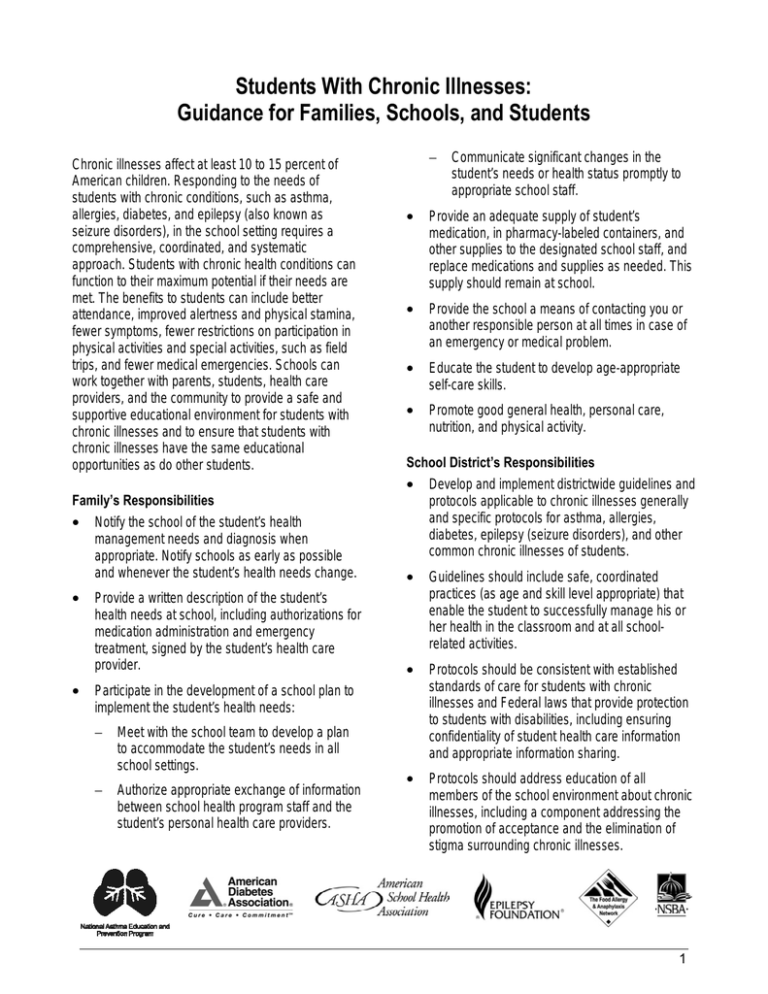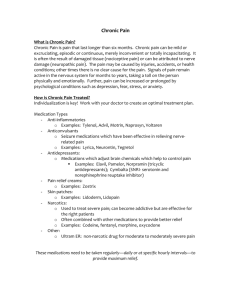Students With Chronic Illnesses: Guidance for Families, Schools, and Students
advertisement

Students With Chronic Illnesses: Guidance for Families, Schools, and Students Chronic illnesses affect at least 10 to 15 percent of American children. Responding to the needs of students with chronic conditions, such as asthma, allergies, diabetes, and epilepsy (also known as seizure disorders), in the school setting requires a comprehensive, coordinated, and systematic approach. Students with chronic health conditions can function to their maximum potential if their needs are met. The benefits to students can include better attendance, improved alertness and physical stamina, fewer symptoms, fewer restrictions on participation in physical activities and special activities, such as field trips, and fewer medical emergencies. Schools can work together with parents, students, health care providers, and the community to provide a safe and supportive educational environment for students with chronic illnesses and to ensure that students with chronic illnesses have the same educational opportunities as do other students. − • Provide an adequate supply of student’s medication, in pharmacy-labeled containers, and other supplies to the designated school staff, and replace medications and supplies as needed. This supply should remain at school. • Provide the school a means of contacting you or another responsible person at all times in case of an emergency or medical problem. • Educate the student to develop age-appropriate self-care skills. • Promote good general health, personal care, nutrition, and physical activity. School District’s Responsibilities • Notify the school of the student’s health management needs and diagnosis when appropriate. Notify schools as early as possible and whenever the student’s health needs change. Develop and implement districtwide guidelines and protocols applicable to chronic illnesses generally and specific protocols for asthma, allergies, diabetes, epilepsy (seizure disorders), and other common chronic illnesses of students. • Provide a written description of the student’s health needs at school, including authorizations for medication administration and emergency treatment, signed by the student’s health care provider. Guidelines should include safe, coordinated practices (as age and skill level appropriate) that enable the student to successfully manage his or her health in the classroom and at all schoolrelated activities. • Protocols should be consistent with established standards of care for students with chronic illnesses and Federal laws that provide protection to students with disabilities, including ensuring confidentiality of student health care information and appropriate information sharing. • Protocols should address education of all members of the school environment about chronic illnesses, including a component addressing the promotion of acceptance and the elimination of stigma surrounding chronic illnesses. Family’s Responsibilities • • • Communicate significant changes in the student’s needs or health status promptly to appropriate school staff. Participate in the development of a school plan to implement the student’s health needs: − Meet with the school team to develop a plan to accommodate the student’s needs in all school settings. − Authorize appropriate exchange of information between school health program staff and the student’s personal health care providers. 1 • Develop, coordinate, and implement necessary training programs for staff that will be responsible for chronic illness care tasks at school and schoolrelated activities. • Monitor schools for compliance with chronic illness care protocols. • Meet with parents, school personnel, and health care providers to address issues of concern about the provision of care to students with chronic illnesses by school district staff. • Communicate with families regularly and as authorized with the student’s health care providers. • Ensure that the student receives prescribed medications in a safe, reliable, and effective manner and has access to needed medication at all times during the school day and at schoolrelated activities. • Be prepared to handle health needs and emergencies and to ensure that there is a staff member available who is properly trained to administer medications or other immediate care during the school day and at all school-related activities, regardless of time or location. • Ensure that all staff who interact with the student on a regular basis receive appropriate guidance and training on routine needs, precautions, and emergency actions. • Provide appropriate health education to students and staff. • Provide a safe and healthy school environment. • Ensure that case management is provided as needed. • Ensure proper record keeping, including appropriate measures to both protect confidentiality and to share information. • Promote a supportive learning environment that views students with chronic illnesses the same as other students except to respond to health needs. • Promote good general health, personal care, nutrition, and physical activity. School’s Responsibilities • • • • • Identify students with chronic conditions, and review their health records as submitted by families and health care providers. Arrange a meeting to discuss health accommodations and educational aids and services that the student may need and to develop a 504 Plan, Individualized Education Program (IEP), or other school plan, as appropriate. The participants should include the family, student (if appropriate), school health staff, 504/IEP coordinator (as applicable), individuals trained to assist the student, and the teacher who has primary responsibility for the student. Health care provider input may be provided in person or in writing. Provide nondiscriminatory opportunities to students with disabilities. Be knowledgeable about and ensure compliance with applicable Federal laws, including Americans With Disabilities Act (ADA), Individuals With Disabilities Education Act (IDEA), Section 504, and Family Educational Rights and Privacy Act of 1974 (FERPA). Be knowledgeable about any State or local laws or district policies that affect the implementation of students’ rights under Federal law. Clarify the roles and obligations of specific school staff, and provide education and communication systems necessary to ensure that students’ health and educational needs are met in a safe and coordinated manner. Student’s Responsibilities • Notify an adult about concerns and needs in managing his or her symptoms or the school environment. • Participate in the care and management of his or her health as appropriate to his or her developmental level. Implement strategies that reduce disruption in the student’s school activities, including physical education, recess, offsite events, extracurricular activities, and field trips. 2






